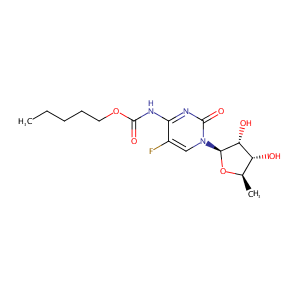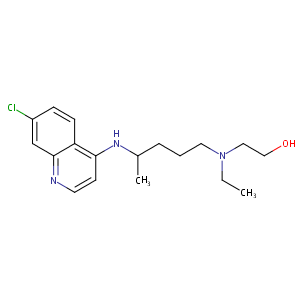| DOT Name |
DOT ID |
UniProt ID |
Mode of Action |
REF |
|
Dihydropyrimidine dehydrogenase (DPYD)
|
OTWRF2NR
|
DPYD_HUMAN
|
Increases Expression
|
[12] |
|
Prostaglandin G/H synthase 2 (PTGS2)
|
OT75U9M4
|
PGH2_HUMAN
|
Decreases Expression
|
[13] |
|
Cyclin-dependent kinase inhibitor 2A (CDKN2A)
|
OTN0ZWAE
|
CDN2A_HUMAN
|
Decreases Expression
|
[13] |
|
C-C motif chemokine 21 (CCL21)
|
OT7DOXEM
|
CCL21_HUMAN
|
Decreases Expression
|
[7] |
|
CCN family member 1 (CCN1)
|
OTKJBEMD
|
CCN1_HUMAN
|
Decreases Expression
|
[7] |
|
Aquaporin-8 (AQP8)
|
OT99JKME
|
AQP8_HUMAN
|
Increases Expression
|
[7] |
|
Complement C3 (C3)
|
OTCH5GS0
|
CO3_HUMAN
|
Decreases Expression
|
[7] |
|
HLA class II histocompatibility antigen, DQ alpha 1 chain (HLA-DQA1)
|
OTC6GISG
|
DQA1_HUMAN
|
Decreases Expression
|
[7] |
|
Interleukin-8 (CXCL8)
|
OTS7T5VH
|
IL8_HUMAN
|
Increases Secretion
|
[14] |
|
B-lymphocyte antigen CD20 (MS4A1)
|
OTZTVUBX
|
CD20_HUMAN
|
Decreases Expression
|
[7] |
|
Nuclear receptor subfamily 4immunitygroup A member 1 (NR4A1)
|
OTGP6GA4
|
NR4A1_HUMAN
|
Decreases Expression
|
[7] |
|
40-kDa huntingtin-associated protein (F8A1)
|
OTXTQ59R
|
HAP40_HUMAN
|
Decreases Expression
|
[7] |
|
Chloride anion exchanger (SLC26A3)
|
OTBNK2U2
|
S26A3_HUMAN
|
Increases Expression
|
[7] |
|
Nuclear receptor subfamily 4 group A member 2 (NR4A2)
|
OT3F9IR2
|
NR4A2_HUMAN
|
Decreases Expression
|
[7] |
|
Potassium-transporting ATPase alpha chain 2 (ATP12A)
|
OTSQSKEK
|
AT12A_HUMAN
|
Increases Expression
|
[7] |
|
Serine/threonine-protein kinase SIK1 (SIK1)
|
OT6FCHME
|
SIK1_HUMAN
|
Decreases Expression
|
[7] |
|
Hemoglobin subunit beta (HBB)
|
OT514IKQ
|
HBB_HUMAN
|
Decreases Expression
|
[7] |
|
Hemoglobin subunit alpha (HBA1)
|
OTW2BQF4
|
HBA_HUMAN
|
Decreases Expression
|
[7] |
|
Paired box protein Pax-5 (PAX5)
|
OTYBJJWX
|
PAX5_HUMAN
|
Decreases Expression
|
[7] |
|
Endoplasmic reticulum aminopeptidase 2 (ERAP2)
|
OTEMENYF
|
ERAP2_HUMAN
|
Decreases Expression
|
[7] |
|
Fc receptor-like A (FCRLA)
|
OT6MK4M1
|
FCRLA_HUMAN
|
Decreases Expression
|
[7] |
|
Leucine-rich repeat-containing protein 15 (LRRC15)
|
OTX7JL8H
|
LRC15_HUMAN
|
Decreases Expression
|
[7] |
|
C-C motif chemokine 19 (CCL19)
|
OTQ2UJMH
|
CCL19_HUMAN
|
Decreases Expression
|
[7] |
|
E3 ubiquitin-protein ligase TRIM31 (TRIM31)
|
OT7VW6RP
|
TRI31_HUMAN
|
Increases Expression
|
[7] |
|
Interleukin-1 receptor type 2 (IL1R2)
|
OT0G7E35
|
IL1R2_HUMAN
|
Increases Response To Substance
|
[8] |
|
Interleukin-17 receptor B (IL17RB)
|
OT0KDNSF
|
I17RB_HUMAN
|
Increases Response To Substance
|
[8] |
|
Glycogen phosphorylase, brain form (PYGB)
|
OT2ZTJT0
|
PYGB_HUMAN
|
Increases Response To Substance
|
[8] |
|
Calcium and integrin-binding protein 1 (CIB1)
|
OT4BVCRU
|
CIB1_HUMAN
|
Increases Response To Substance
|
[8] |
|
1-acyl-sn-glycerol-3-phosphate acyltransferase beta (AGPAT2)
|
OT5I4Y9K
|
PLCB_HUMAN
|
Increases Response To Substance
|
[8] |
|
cAMP-dependent protein kinase catalytic subunit beta (PRKACB)
|
OT6RMDCE
|
KAPCB_HUMAN
|
Decreases Response To Substance
|
[8] |
|
Claudin-3 (CLDN3)
|
OT71MN9S
|
CLD3_HUMAN
|
Increases Response To Substance
|
[8] |
|
Replication protein A 70 kDa DNA-binding subunit (RPA1)
|
OT76POLP
|
RFA1_HUMAN
|
Decreases Response To Substance
|
[8] |
|
Protein flightless-1 homolog (FLII)
|
OT7G9JG6
|
FLII_HUMAN
|
Decreases Response To Substance
|
[8] |
|
Stress-induced-phosphoprotein 1 (STIP1)
|
OT7TXLOX
|
STIP1_HUMAN
|
Decreases Response To Substance
|
[8] |
|
Ras-related protein R-Ras2 (RRAS2)
|
OT83NCEB
|
RRAS2_HUMAN
|
Decreases Response To Substance
|
[8] |
|
Hypoxia-inducible factor 1-alpha (HIF1A)
|
OTADSC03
|
HIF1A_HUMAN
|
Decreases Response To Substance
|
[8] |
|
Cocaine esterase (CES2)
|
OTC647SQ
|
EST2_HUMAN
|
Increases Response To Substance
|
[15] |
|
Ras-related protein Rab-40B (RAB40B)
|
OTCA9ZF5
|
RB40B_HUMAN
|
Increases Response To Substance
|
[8] |
|
Trefoil factor 1 (TFF1)
|
OTCYQH4F
|
TFF1_HUMAN
|
Increases Response To Substance
|
[8] |
|
Iron-sulfur clusters transporter ABCB7, mitochondrial (ABCB7)
|
OTDNTHNR
|
ABCB7_HUMAN
|
Decreases Response To Substance
|
[8] |
|
Tyrosine-protein phosphatase non-receptor type 13 (PTPN13)
|
OTESFZSO
|
PTN13_HUMAN
|
Decreases Response To Substance
|
[8] |
|
ADP-ribosylation factor-like protein 4D (ARL4D)
|
OTG5I3KU
|
ARL4D_HUMAN
|
Decreases Response To Substance
|
[8] |
|
Double-strand break repair protein MRE11 (MRE11)
|
OTGU8TZM
|
MRE11_HUMAN
|
Decreases Response To Substance
|
[8] |
|
Inorganic pyrophosphatase (PPA1)
|
OTHZK1QB
|
IPYR_HUMAN
|
Increases Response To Substance
|
[8] |
|
Polycystin-2 (PKD2)
|
OTIXBU8H
|
PKD2_HUMAN
|
Decreases Response To Substance
|
[8] |
|
Protein S100-P (S100P)
|
OTJCXNJG
|
S100P_HUMAN
|
Increases Response To Substance
|
[8] |
|
Transcriptional activator Myb (MYB)
|
OTJH64IV
|
MYB_HUMAN
|
Increases Response To Substance
|
[8] |
|
1-phosphatidylinositol 4,5-bisphosphate phosphodiesterase epsilon-1 (PLCE1)
|
OTJISZOX
|
PLCE1_HUMAN
|
Increases Response To Substance
|
[8] |
|
Plakophilin-2 (PKP2)
|
OTJOVF68
|
PKP2_HUMAN
|
Increases Response To Substance
|
[8] |
|
Transcriptional enhancer factor TEF-1 (TEAD1)
|
OTK6971C
|
TEAD1_HUMAN
|
Decreases Response To Substance
|
[8] |
|
Tyrosine-protein kinase receptor UFO (AXL)
|
OTKA2SUX
|
UFO_HUMAN
|
Decreases Response To Substance
|
[8] |
|
Myelin regulatory factor (MYRF)
|
OTKF6AEB
|
MYRF_HUMAN
|
Increases Response To Substance
|
[8] |
|
Galectin-4 (LGALS4)
|
OTKQCG0H
|
LEG4_HUMAN
|
Increases Response To Substance
|
[8] |
|
Four and a half LIM domains protein 1 (FHL1)
|
OTN535SU
|
FHL1_HUMAN
|
Decreases Response To Substance
|
[8] |
|
Hepatoma-derived growth factor-related protein 3 (HDGFL3)
|
OTNN7WYH
|
HDGR3_HUMAN
|
Decreases Response To Substance
|
[8] |
|
E3 ubiquitin-protein ligase TRIM15 (TRIM15)
|
OTNYAKP6
|
TRI15_HUMAN
|
Increases Response To Substance
|
[8] |
|
Dermatan-sulfate epimerase (DSE)
|
OTQ108VJ
|
DSE_HUMAN
|
Decreases Response To Substance
|
[8] |
|
Anterior gradient protein 2 homolog (AGR2)
|
OTRRZT7W
|
AGR2_HUMAN
|
Increases Response To Substance
|
[8] |
|
Receptor tyrosine-protein kinase erbB-3 (ERBB3)
|
OTRSST0A
|
ERBB3_HUMAN
|
Increases Response To Substance
|
[8] |
|
Aldo-keto reductase family 1 member B1 (AKR1B1)
|
OTRX72TH
|
ALDR_HUMAN
|
Decreases Response To Substance
|
[8] |
|
Aldo-keto reductase family 1 member C3 (AKR1C3)
|
OTU2SXBA
|
AK1C3_HUMAN
|
Increases Response To Substance
|
[8] |
|
3-ketoacyl-CoA thiolase, peroxisomal (ACAA1)
|
OTVKRET0
|
THIK_HUMAN
|
Increases Response To Substance
|
[8] |
|
Tissue alpha-L-fucosidase (FUCA1)
|
OTW71IK4
|
FUCO_HUMAN
|
Increases Response To Substance
|
[8] |
|
GTPase HRas (HRAS)
|
OTWQN0DP
|
RASH_HUMAN
|
Decreases Response To Substance
|
[8] |
|
Epidermal growth factor receptor kinase substrate 8 (EPS8)
|
OTZ6ES6V
|
EPS8_HUMAN
|
Increases Response To Substance
|
[8] |
| ------------------------------------------------------------------------------------ |
|
|
|
|


